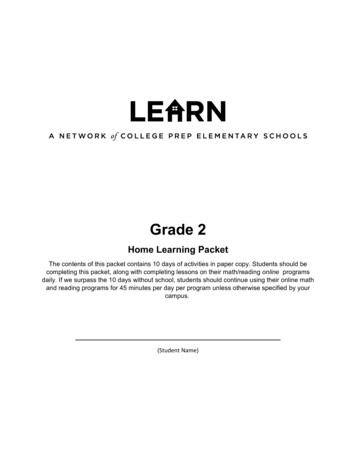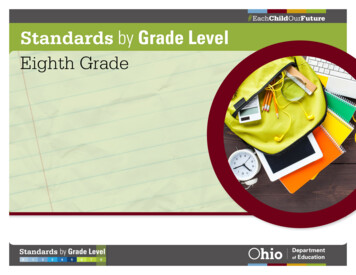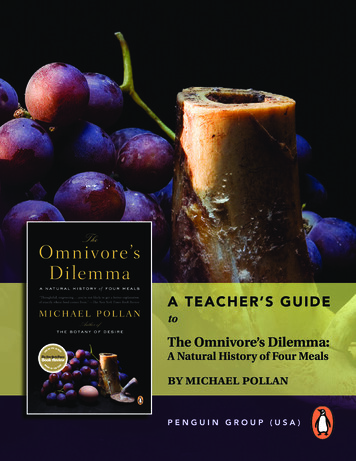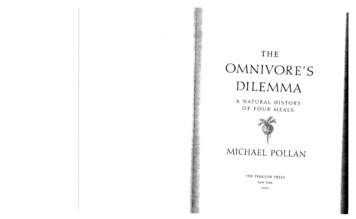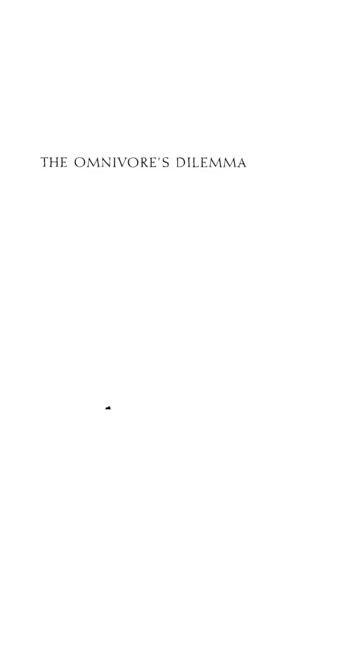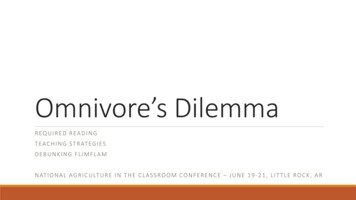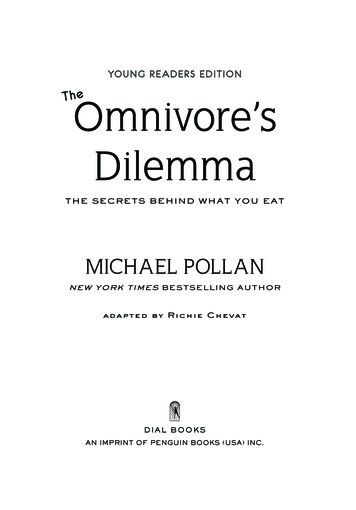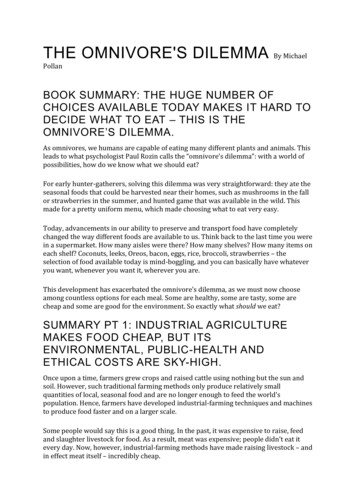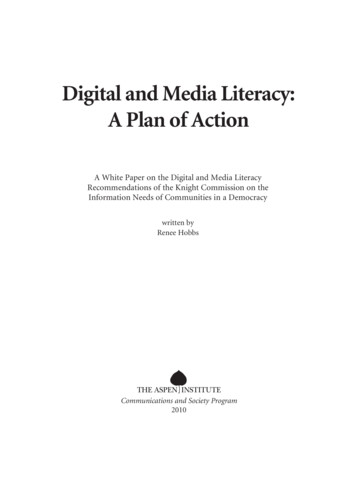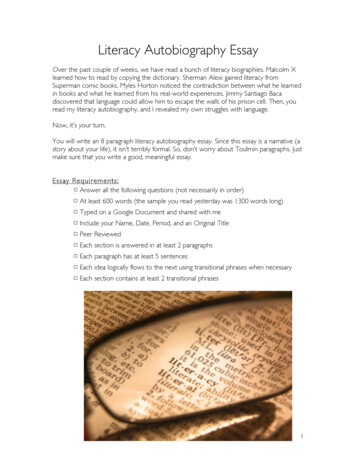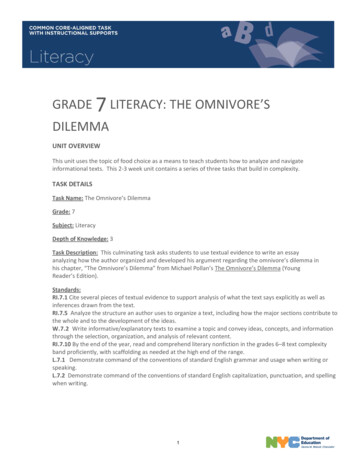
Transcription
GRADE 7 LITERACY: THE OMNIVORE’SDILEMMAUNIT OVERVIEWThis unit uses the topic of food choice as a means to teach students how to analyze and navigateinformational texts. This 2-3 week unit contains a series of three tasks that build in complexity.TASK DETAILSTask Name: The Omnivore’s DilemmaGrade: 7Subject: LiteracyDepth of Knowledge: 3Task Description: This culminating task asks students to use textual evidence to write an essayanalyzing how the author organized and developed his argument regarding the omnivore’s dilemma inhis chapter, “The Omnivore’s Dilemma” from Michael Pollan’s The Omnivore’s Dilemma (YoungReader’s Edition).Standards:RI.7.1 Cite several pieces of textual evidence to support analysis of what the text says explicitly as well asinferences drawn from the text.RI.7.5 Analyze the structure an author uses to organize a text, including how the major sections contribute tothe whole and to the development of the ideas.W.7.2 Write informative/explanatory texts to examine a topic and convey ideas, concepts, and informationthrough the selection, organization, and analysis of relevant content.RI.7.10 By the end of the year, read and comprehend literary nonfiction in the grades 6–8 text complexityband proficiently, with scaffolding as needed at the high end of the range.L.7.1 Demonstrate command of the conventions of standard English grammar and usage when writing orspeaking.L.7.2 Demonstrate command of the conventions of standard English capitalization, punctuation, and spellingwhen writing.1
TABLE OF CONTENTSThe task and instructional supports in the following pages are designed to help educators understandand implement tasks that are embedded in Common Core-aligned curricula. While the focus for the2011-2012 Instructional Expectations is on engaging students in Common Core-aligned culminatingtasks, it is imperative that the tasks are embedded in units of study that are also aligned to the newstandards. Rather than asking teachers to introduce a task into the semester without context, thiswork is intended to encourage analysis of student and teacher work to understand what alignmentlooks like. We have learned through the 2010-2011 Common Core pilots that beginning with rigorousassessments drives significant shifts in curriculum and pedagogy. Universal Design for Learning (UDL)support is included to ensure multiple entry points for all learners, including students with disabilitiesand English language learners.PERFORMANCE TASK: THE OMNIVORE’S DILEMMA . 3UNIVERSAL DESIGN FOR LEARNING (UDL) PRINCIPLES . 8RUBRIC . 10ANNOTATED STUDENT WORK . 15INSTRUCTIONAL SUPPORTS . 29UNIT OUTLINE .30ASSESSMENT TASK 1 . 37ASSESSMENT TASK 1 RUBRIC . 41ASSESSMENT TASK 2 . 44ASSESSMENT TASK 2 RUBRIC . 48SUPPORTING MATERIALS . 51SUPPORTS FOR ENGLISH LANGUAGE LEARNERS. 61SUPPORTS FOR STUDENTS WITH DISABILITIES . 65Acknowledgements: This unit was developed by Lavern Nelson (CFN 302) and Barbara Stripling with inputfrom the Curriculum Designers Alignment Review Team. The tasks were developed by the 2010-2011 NYCDOE Middle School Performance Based Assessment Pilot Design Studio Writers.2
GRADE 7 LITERACY: THE OMNIVORE’SDILEMMAPERFORMANCE TASK3
Student Name:School:Class Period:New York City Middle School Pilot Project Performance-BasedAssessment (PBA) on Informational Text Grade 7, Task #3TASK: Write an informative/explanatory essay of approximately one page in which you analyzehow the author in his chapter, “The Omnivore’s Dilemma,” organized and developed his argumentregarding the omnivore’s dilemma. Begin by introducing Pollan’s argument and previewing whatwill follow in your essay. Continue by explaining how Pollan organized the chapter to develop hisargument. Cite textual evidence, including how the chapter’s major sections contribute to thereader’s overall perspective on the argument as well as how the chapter sections help readersdevelop their understanding of the argument. Use transitions to help the reader clarifyrelationships among the ideas you are explaining. End your essay with a concluding statement orsection. Your essay should be written in a formal style for an audience that is familiar with the textand follow the conventions of standard English, including simple and compound sentences andspelling.Answer the questions below to plan your writing. Your answers will be collected but not graded.Compose your informative/explanatory essay on the following pages. After you’ve written yourresponse, answer the StepBack questions. Your answers to the StepBack questions will also becollected but not graded.Space for Notes:Grade 7: PBA on Informational Text, Task 3CCSS: RI.7.5; W.7.2; L.7.1, L.7.24
Task: Write an informative/explanatory essay of approximately one page in which you analyzehow the author in his chapter, “The Omnivore’s Dilemma,” organized and developed hisargument regarding the omnivore’s dilemma. Begin by introducing Pollan’s argument andpreviewing what will follow in your essay. Continue by explaining how Pollan organized thechapter to develop his argument. Cite textual evidence, including how the chapter’s majorsections contribute to the reader’s overall perspective on the argument as well as how thechapter sections help readers develop their understanding of the argument. Use transitions tohelp the reader clarify relationships among the ideas you are explaining. End your essay with aconcluding statement or section. Your essay should be written in a formal style for an audiencethat is familiar with the text and follow the conventions of standard English, including simple andcompound sentences and spelling.Compose Your Essay in the Space Below:Grade 7: PBA on Informational Text, Task 3CCSS: RI.7.5; W.7.2; L.7.1, L.7.25
Grade 7: PBA on Informational Text, Task 3CCSS: RI.7.5; W.7.2; L.7.1, L.7.26
StepBack Questions: Please answer the following questions in the space below. Yourresponses will be collected but not graded.Ø What did you do to complete the Performance-Based Assessment task? List the stepsthat you took to complete the task.Ø What did you find easy about the Performance-Based Assessment task?Ø What did you find difficult about the Performance-Based Assessment task?Grade 7: PBA on Informational Text, Task 3CCSS: RI.7.5; W.7.2; L.7.1, L.7.27
GRADE 7 LITERACY: THE OMNIVORE’SDILLEMAUNIVERSAL DESIGN FOR LEARNING (UDL)PRINCIPLES8
Grade 7 The Omnivore’s DilemmaCommon Core Learning Standards/Universal Design for LearningThe goal of using Common Core Learning Standards (CCLS) is to provide the highest academicstandards to all of our students. Universal Design for Learning (UDL) is a set of principles thatprovides teachers with a structure to develop their instruction to meet the needs of a diversity oflearners. UDL is a research-based framework that suggests each student learns in a unique manner.A one-size-fits-all approach is not effective to meet the diverse range of learners in our schools. Bycreating options for how instruction is presented, how students express their ideas, and howteachers can engage students in their learning, instruction can be customized and adjusted to meetindividual student needs. In this manner, we can support our students to succeed in the CCLS.Below are some ideas of how this Common Core Task is aligned with the three principles of UDL;providing options in representation, action/expression, and engagement. As UDL calls for multipleoptions, the possible list is endless. Please use this as a starting point. Think about your own groupof students and assess whether these are options you can use.REPRESENTATION: The “what” of learning. How does the task present information and content indifferent ways? How students gather facts and categorize what they see, hear, and read. How arethey identifying letters, words, or an author's style?In this task, teachers can ü Activate or supply prior knowledge by using advanced organizers (e.g., KWLmethods, concept maps) on the topic.ACTION/EXPRESSION: The “how” of learning. How does the task differentiate the ways thatstudents can express what they know? How do they plan and perform tasks? How do studentsorganize and express their ideas?In this task, teachers can ü Provide options for executive functions by giving timely feedback that is informativeand will guide learners with monitoring their progress and guiding their efforts andpractices through the use of rubrics.ENGAGEMENT: The “why” of learning. How does the task stimulate interest and motivation forlearning? How do students get engaged? How are they challenged, excited, or interested?In this task, teachers can ü Provide options for self regulation so that students can collect and chart data for thepurpose of self monitoring and regulating changes in their own performance.Visit /default.htm to learn more information about UDL.9
GRADE 7 LITERACY: THE OMNIVORE’SDILEMMARUBRICThis task was scored using a primary trait rubric and a secondary trait rubric.Primary trait rubrics focus attention on rating of a single trait considered to be the most essential fordemonstrating success regarding a particular product or performance. They can be used mosteffectively by teachers with the ELA model of assessment tasks for several reasons. First, by isolatingone component of written discourse to assess, primary trait scoring allows raters or teachers to focussharply on that component without being distracted by many other possibilities. The component thatis chosen for assessment is not just any component but one that is essential to success on a particularassessment task. The study of the work is focused on the heart of the task. If students are weak onthe heart of the task, teachers have sufficient data to plan lessons for re-teaching and/or modificationof lessons. Also, because the scoring guide uses language from the task and CCSS to define its scorelevels, it allows for greater alignment between the task assigned and the trait or dimension beingassessed. At the very least, anyone who looks at the scoring guide rubric should expect to see such aconnection. For its specificity and clarity alone, primary trait rubrics offer important advantages overother means of scoring.Secondary trait rubrics identify assessed skills and content from the task that have not been identifiedin the primary trait rubric. They accompany primary trait rubrics and are used after primary traitrubrics.10
Grade 7 Literacy: Omnivore’s DilemmaPrimary and Secondary Trait Scoring Guide for Assessment Task 3Primary Trait: Explanation of an author’s argument and analysis of its organization anddevelopment, including how the major sections contribute to the whole.Scoring GuideScore Point4321DescriptionInformative/explanatory text that describes Pollan’s argument regarding theomnivore’s dilemma. The explanatory response includes a detailed analysis oftextual evidence to show how Pollan organizes the chapter to develop hisargument, including how the major sections contribute to the reader’sunderstanding of the argument. All of the chapter’s major sections areanalyzed.Informative/explanatory text that describes Pollan’s argument regarding theomnivore’s dilemma. The explanatory response includes a general analysis oftextual evidence to show how Pollan organizes the chapter to develop hisargument, including how the major sections contribute to the reader’sunderstanding of the argument. At least five of the chapter’s major sections areanalyzed.Informative/explanatory text that identifies Pollan’s argument regarding theomnivore’s dilemma. The explanatory response includes limited analysis oftextual evidence to show how Pollan organizes the chapter to develop hisargument. For example, two or three major sections may be included, but thecontribution of each to the reader’s understanding of the argument isunexplained.Informative/explanatory text that may or may not accurately identify Pollan’sargument regarding the omnivore’s dilemma. It includes few ideas or examplesthat demonstrate how Pollan organizes the chapter to develop his argument. Ifmajor sections are identified, their relationship to the argument is unexplained.11
Grade 7 Literacy: Omnivore’s DilemmaPrimary and Secondary Trait Scoring Guide for Assessment Task 3Secondary Trait #1 of Assessment Task 3:Explanatory text develops a topic using relevant examples and includes a clear introduction oftopic, connecting words and phrases (i.e., transitions), and a concluding statement or section.Scoring Guide4Explanatory text develops a topic with relevant examples or other information.The ideas are organized using transitions that are appropriate to the content andhelp to clarify relationship among ideas. The topic is introduced clearly and thereis a concluding statement or section that relates directly to the information orexplanation presented.3Explanatory text develops a topic with relevant examples or other information.The ideas are organized using transitions that are limited but appropriate. Thetopic is introduced clearly. The relevance of the concluding statement or sectionis unexplained.2Explanatory text is developed examples or other information that may beirrelevant. Transitions are limited or used inappropriately. The topic is introduced,but there is no concluding statement or section.1The paper is developed with information and details that are not relevant. Thereare no transitions that help to clarify relationships among ideas.Examples of Connecting Words and Phrases (i.e., transitions) First, second, thirdInitially, to begin, next, then, finally, in conclusionAlthough, instead of, because ofIn this wayTherefore, as a consequenceWhile Unlike , as opposed to, in contrast to12
Grade 7 Literacy: Omnivore’s DilemmaPrimary and Secondary Trait Scoring Guide for Assessment Task 3Secondary Trait #2 of Assessment Task 3: Student explanation demonstrates use ofstandard English focusing on punctuation, simple and compound sentences, and spelling whenwriting.Scoring Guide4Consistently uses standard English grammar and usage, including accepted use ofsimple and compound sentences and spelling.3Generally uses standard English grammar and usage, including accepted use ofsimple and compound sentences and spelling.2Only sometimes uses standard English grammar and usage, including accepted useof simple and compound sentences and spelling.1Little evidence of use of standard English grammar and usage, including accepteduse of simple and compound sentences) and spelling.13
Grade 7 Literacy: Omnivore’s DilemmaPrimary and Secondary Trait Scoring Guide for Assessment Task 3Explicit Statements about What Will Be Expected as Evidence of a Score Point 4Primary Trait: Explanation of an author’s argument and analysis of its organization anddevelopment, including how the major sections contribute to the whole.Score Point 4Informative/explanatory text that describes Pollan’s argument regarding the omnivore’sdilemma. The explanatory response includes a detailed analysis of textual evidence to showhow Pollan organizes the chapter to develop his argument, including how the major sectionscontribute to the reader’s understanding of the argument. All of the chapter’s major sections areidentified.Pollan’s argument: Making informed, wise choices about what to eat has become anincreasingly big dilemma for Americans.Example of an explanatory statement with textual evidence related to how Pollanintroduces the chapter’s argument:Pollan opens the chapter by explaining that one of the most basic causes of our dilemma asomnivores is due to the very fact that we have to eat a variety of foods to survive, and thatmeans always having to make decisions about what to eat. In this way, Pollan introduces hisargument by showing us that our dilemma is the result of many factors, one of them being ourvery nature as humans.Example of an explanatory statement with textual evidence related to how Pollandevelops the argument:In the second section, “The Modern Omnivore,” Pollan continues to develop his argument byexplaining how contemporary humans have lost the cultural traditions that helped them makewise decisions about what to eat. Unlike our ancestors who depended upon their own parentsand grandparents to tell them what to eat, we have to put a good deal of thought into deciding.Pollan cites the loss of these traditions as another reason our dilemma has grown morecomplicated.14
GRADE 7 LITERACY: THE OMNIVORE’SDILEMMAANNOTATED STUDENT WORKDue to revisions made to the third task, there is no student work currently available for the third assessmenttask. Thus, we have included annotated student work for Task 1 and Task 2. As we pilot the third assessmentand student work becomes available, we will include student work for Task 3.15
Grade 7 Literacy: The Omnivore’s DilemmaAnnotated Student WorkAnnotated Anchor Papers for Each Primary Trait Score PointAssessment Task 1Primary Trait: Explanation that determines meaning of figurative phrase and cites textualevidence to support an analysis of explicit and inferred information from a text.Primary Trait Score Point 4Informative/explanatory text that accurately explains the phrase omnivore’s dilemma andprovides sufficient pieces of textual evidence to support an analysis of the causes of thedilemma. The analysis draws on what the text says explicitly as well as what can be inferredand includes no misconceptions about the text.Student Work Sample Score Point 4What exactly is the Omnivore’s Dilemma? The dilemma is a human one becausehumans are omnivores, meaning we eat both meat and plants to survive. Omnivores eateverything and sometimes everything isn’t really good for you. Carnivores who only eat meantand herbivores who only eat plants have to focus on finding just those kinds of foods and don’thave the dilemma humans have of eating food which keeps us alive but doesn’t always keep ushealthy.In Chapter 8, “Is that food?” the author explains to us that omnivores have a variety offoods to eat. A normal omnivore has a wide range of food. Now, this really contributes to the“Ominvores Dilemma”. We eat so much and so many different kinds of food, that we don’t evenknow what we’re stuffing into our mouths! Unlike Koalas and Monarch Butterflies, who only eatone type of food, we eat just about everything. We also have to remember that humans eat somany different kinds of foods to stay alive, but what we don’t know is that not all the food that isbeing prepared for us and goes into our body to keep us alive will keep us healthy.According to the author, we, meaning humans over hundreds of years, went fromknowing what to eat, to not knowing what we eat! It was simple back then. We ate depending onthe seasons and what we could find in the woods or what we could hunt. We used to know howto solve the “Ominvores Dilemma”. What happened to us? Now we eat just about everythingthere is because junk food is easier to buy than healthier choices which we can’t find as easilyor that don’t look as good to us. It’s not completely our fault. It’s also the food industries fault.On pg. 87, the author says “standing in our giant supermarkets, we feel more lost than someonestanding in the forest 10,000 years ago.” Now that’s serious. The “Ominvores Dilemma” isn’t anunsolveable problem. We as people need to cut down on eating, and focus on what we areeating. We need to resist poor food choices in supermarkets and pay attention to what we put inour mouths.The author states, again on page 87, “Sometimes it even seems like we’ve forgottenwhy we eat.” As humans, we have a big brain, so we eat a lot, to have enough brain power. Werely on our senses when we eat, but the koalas rely on instincts. Pollan, the author, explains toreaders why our senses cause us to eat so much. Back in the early life, we were hunters andgatherers. It was really hard finding food, so when we did find some, we ate as much as wepossibly could because, we didn’t know if we were ever going to eat again. Today, finding sweetthings to eat is not as hard as it was when we were cavemen. But we continue to eat as if we Student work sample content modified when necessary to achieve score point.16Comment [A1]: This is an accuratedefinition and explanation of the omnivore’sdilemma.Comment [A2]: The writer referencesboth explicit and implicit information fromthe text to explain one cause of the dilemma.Comment [A3]: In this paragraph, thewriter concisely explains two causes of thedilemma. The writer infers from the textthat modern omnivores no longer knowwhat to eat. He/she also provides explicitdetails from the text, including a directquote, to illustrate the role of the foodindustry in the omnivore’s dilemma.
Grade 7 Literacy: The Omnivore’s DilemmaAnnotated Student Workwill starve tomorrow. It is easier for humans to get trapped into eating too much because ittastes good even when we are no longer hungry.SummaryThis student work sample provides an example of a score point 4 on the primary trait andsecondary trait.Criterion & Score PointEvidenceInstructional NextSteps Primary Trait:Explanation thatdetermines meaning offigurative phrase andcites textual evidence tosupport an analysis ofexplicit and inferredinformation from a text.(Score Point 4)The student writer accurately explains thephrase “omnivore’s dilemma” by restatingthe denotative meaning of the term“omnivore” and describing the dilemma inhis/her own words. He/she providesseveral pieces of textual evidence tosupport an analysis of the causes of thedilemma. The student draws on what thetext states explicitly (i.e., direct quotes,paraphrases) and makes inferences fromthe text about the food industry beingpartly to blame for the omnivore’sdilemma (e.g., “junk food is easier to buythan healthier choices”). The studentincludes no misconceptions about thetext.One possible next stepfor this student wouldinclude working ondeveloping aconcluding statementor section that followsfrom and supports theexplanation presented.The student maybenefit from studyingand discussing avariety of concludingstatements or sectionsfrom otherinformative/explanatoryessays noting theirfeatures and potentialimpact on readers.Secondary Trait:Student explanationdemonstrates use ofstandard Englishfocusing on punctuation,simple and compoundsentences, and spelling.(Score Point 4)The writer generally uses standardEnglish grammar and usage, includingaccepted use of simple and compoundsentences. There are very few spellingerrors (e.g., unsolveable); however,because this is an on demand task, minorerrors are expected. Additionally, theerrors do not get in the way of a reader’scomprehension.N/A Instructional next steps are provided for only the primary trait or the “heart” of the task. Suggestions toimprove achievement of a secondary trait(s) can go in multiple directions and the direction suggestedcannot be determined until the student writer has achieved at least a satisfactory achievement of theprimary trait.17Comment [A4]: Here the writerreferences explicit information from the text(i.e., direct quotation) and makes inferencesabout the modern omnivore to explain onecause of the dilemma.
Grade 7 Literacy: The Omnivore’s DilemmaAnnotated Student WorkPrimary Trait Score Point 3Informative/explanatory text that explains the omnivore’s dilemma generally using limited textualevidence. The explanation of the textual evidence includes reasons why the author believes thedilemma exists. There are no misconceptions about the text.Student Work Sample Score Point 3In the chapter, “The Omnivores Dilemma” we focused on three sections. Those sectionswere “Is That Food?”, “The Modern Omnivore”, and “The Omnivore”s Brain”. The omnivore’sdilemma can be broken down into two things. Omnivore which means devour everything anddilemma which is a problem, issue, or setback. Each section of the chapter talks about adifferent aspect of what it means to eat meat and plants as omnivores and why this is a problemor issue.In the section “Is That Food?” the author basically talks about how the food we eatcompares to the food animals eat. Also, the difference between a humans diet compared to ananimals diet. Likewise, the author says that we need certain things that we just can’t getbecause the “industrial food chain” (p. 86) gives us too many choices. Pollan states, “Ultimatelyour omnivore’s dilemma is rooted in our nature as human beings—but we’ve made our choicesmuch harder than they used to be” (p. 86). This is basically saying human problems start withsimple ways of doing things and then people who make food make it harder to eat the right way.In “The Modern Omnivore” it’s saying that over thousands of years our eating habitshave really changed. They used to follow rules and habits that made eating healthy mucheasier. It was based on culture. Likewise, it says that today the modern omnivore has no foodculture to fall back on. We no longer know what foods are good and not good for us. Pollan saysthat “we need to recover the skills and knowledge people used to have” (p.87). In the section itsays “we no longer know for sure what foods are good for us and which aren’t”. Meaning, wedon’t even know what our foods are really made of or if we should eat them or not. If we had afood culture we would probably know today.In the section “The Omnivores Brain”, the author is talking about how we need to eat acertain amount of food. Also eating the right foods to keep our bodies functioning properly. Weneed to eat wisely. In the chapter, “for us, choosing food is a problem that has to be solved withour brains and our senses”. This means that choosing foods for humans has to be done usingour brains and senses and nothing else. We have problems with choosing foods.Our “omnivores dilemma” is something that we must choose to fix on our own. Nobodycan do it. We must pick and choose carefully how we treat our “omnivores dilemma”. Our“omnivores dilemma” can go away if we choose the right kinds of food. It’s our choice.SummaryThis student work sample provides an example of a score point 3 on the primary trait and thesecondary trait.Criterion & Score PointEvidencePrimary Trait:Explanation thatdetermines meaning offigurative phrase andThe student writer breaks down themeaning of the terms “omnivore” and“dilemma,” but does not explicitly statewhat Pollan means by the phrase Instructional NextSteps One possible next stepfor this student wouldinclude working tostrengthen his/herInstructional next steps are provided for only the primary trait or the “heart” of the task. Suggestions toimprove achievement of a secondary trait(s) can go in multiple directions and the direction suggestedcannot be determined until the student writer has achieved at least a satisfactory achievement of theprimary trait.18Comment [A5]: In these sentences thewriter provides a general explanation of thephrase “omnivore’s dilemma” that isinferred from the text.Comment [A6]: In these sentences thewriter quotes directly from the text toexplain one cause of the omnivore’sdilemma. The writer explains the quotes byinferring that the industry has made it moredifficult to eat well.Comment [A7]: In these sentences thewriter provides implicit information fromthe text to explain another cause for theomnivore’s dilemma. The quote used by thewriter is not explained and does notcontribute to the understanding of theomnivore’s dilemma.Comment [A8]: Here the writer providesa quote from the text, explains the quote,and makes an inference about therelationship between food culture and foodknowledge, another cause of the omnivore’sdilemma.Comment [A9]: In these sentences thewriter strays from the task of explainingcauses for the omnivore’s dilemma andinstead talks about solutions.
Grade 7 Literacy: The Omnivore’s DilemmaAnnotated Student Workcites textual evidence tosupport an analysis ofexplicit and inferredinformation from a text.(Score Point 3)“omnivore’s dilemma.” The studentprovides limited textual evidence tosupport an analysis of the dilemma. Forexample, he/she uses direct quotes fromthe text to conclude that “humanproblems start with simple ways of doingthings and then people who make foodmake it harder to eat the right way.”However, the student only generallyexplains the role of the food industry inthe omnivore’s dilemma. The explanationof the textual evidence includes reasonswhy the author believes the dilemmaexists— e.g., having too many choicesand changing eating habits over time.While there are no misconceptions aboutthe text, the student discusses solutionsto the omnivore’s dilemma (which is notnecessary for the task).analysis by usingspecific and thoroughexplanations to supporthis/her key points. Thestudent may benefitfrom studying anddiscussing otherinformative/explanatoryessays about textsnoting how the writerfocuses on key pointsand follows throughwith a thoroughanalysis.Secondary Tra
The Omnivore’s Dilemma . Grade: 7 . Subject: Literacy . Depth of Knowledge: 3 . Task Description: This culminating task asks students to use textual evidence to write an essay analyzing how the author organized and developed his argument regarding the omnivore’s dilemma in his chapter, “The
